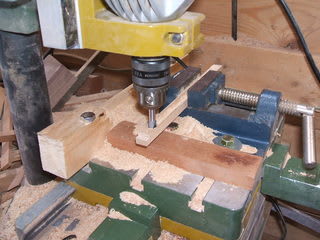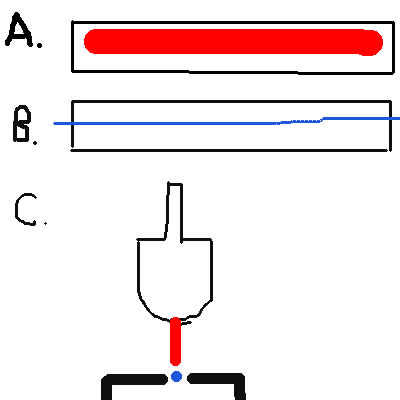How I spent my time today?
Well, the whole morning was spent on watching the games.
It was still warm, in the afternoon, but armed with yesterday's
purchase I was confident that I should be able to achieve
something, and what follows is indicative of that...

You have seen them before, of course, but their tips have not been
rounded. I rounded them today, albeit only 10 of them. I will have to
deal with the remaining 30 odd pairs, tommorrow.
I also did some more work. In fact, I managed to make trenches
with the 4 containers, as can be seen bellow. I even made
chopstics for 3 of them, the last pair of them is to be
made tommorrow.

Can you see that one of them is empty? Anyway, all in all,
what I talk about today must be trench making and the
milling machine operation.
What follows should give you some idea of what is
involved...

What you are looking at is this. The container to be
is firmly gripped by the vice on the X-Y table. X-Y
table means that the workpiece, the vice, and the table itself
can move horizontally, in any direction I want. You are
also looking at the tip of my round-head bit sunk into
the container to be.
There is a substantial issue here, that is, how do you
know that your trenches are centred with respect to the
edges on either side.
Normally, you use what can be seen bellow.

This is a commercially available device for drawing a centre
line. I do not go into details. Suffice to say that it can be
useful if the width of your workpiece is wider than, say, 30mm.
With the containers, you are talking about something like
12mm starting width (starting? because their width can be
narrowed down later).
Even if you have the correct centre line for reference, it
is no good unless you have a very pointed end to your bit,
as indicated in the next illustration.

Here, C. is the bit under discussion and the red bar going
vertical from its tip, pointing at the blue dot (centre line)
is our ficticious pointed end. In reality, there is not
such a pointed end!
Anyway, A. is not what we want. B. is the non-existent and
imaginary centre line. What I am trying to say is that I
do not have any of these two essentials.
So, the question is how do I go about this business of
making the trenches equidistant form the ends.
The next illustration is my attmept to explain all this.

With A. I have just made a very short and shallow trench.
Obviously, this trench is not at the centre and needs to go up
a bit, as indicated by the blue arrow.
Needless to say that prior to all this I very carefully
set my bit as equidistant as possible from the two sides.
And, I failed!
B's slightly longer trace is more like the correct line
to be followed (longer red line above initial short line).
Here, you obvisouly have a mess, two shallow trenches side
by side. However, the black arrow in the middle is suggesting
that this mess will be obliterated as the tip of the bit
goes deeper into the workpiece. After all, I am using a round head
bit, specifically for this purpose!
C. and D., D is the L shaped jig, and C is telling you,
in the absence of an appropriate divider how you might
to guess where the centre line might be.
You press the L shaped jig to one side of your piece
and draw the first line, then do the same from the other side.
You then end up two lines as shown in C. The real centre line
is somewhere between these two blue lines. Naturally, the precision
will be increased the narrower the interline spacing.
Ideal situation is where the interline spacing is equal
to the blade width. This rarely happens, of course, and
you must be content withit!



Well, the whole morning was spent on watching the games.
It was still warm, in the afternoon, but armed with yesterday's
purchase I was confident that I should be able to achieve
something, and what follows is indicative of that...

You have seen them before, of course, but their tips have not been
rounded. I rounded them today, albeit only 10 of them. I will have to
deal with the remaining 30 odd pairs, tommorrow.
I also did some more work. In fact, I managed to make trenches
with the 4 containers, as can be seen bellow. I even made
chopstics for 3 of them, the last pair of them is to be
made tommorrow.

Can you see that one of them is empty? Anyway, all in all,
what I talk about today must be trench making and the
milling machine operation.
What follows should give you some idea of what is
involved...

What you are looking at is this. The container to be
is firmly gripped by the vice on the X-Y table. X-Y
table means that the workpiece, the vice, and the table itself
can move horizontally, in any direction I want. You are
also looking at the tip of my round-head bit sunk into
the container to be.
There is a substantial issue here, that is, how do you
know that your trenches are centred with respect to the
edges on either side.
Normally, you use what can be seen bellow.

This is a commercially available device for drawing a centre
line. I do not go into details. Suffice to say that it can be
useful if the width of your workpiece is wider than, say, 30mm.
With the containers, you are talking about something like
12mm starting width (starting? because their width can be
narrowed down later).
Even if you have the correct centre line for reference, it
is no good unless you have a very pointed end to your bit,
as indicated in the next illustration.

Here, C. is the bit under discussion and the red bar going
vertical from its tip, pointing at the blue dot (centre line)
is our ficticious pointed end. In reality, there is not
such a pointed end!
Anyway, A. is not what we want. B. is the non-existent and
imaginary centre line. What I am trying to say is that I
do not have any of these two essentials.
So, the question is how do I go about this business of
making the trenches equidistant form the ends.
The next illustration is my attmept to explain all this.

With A. I have just made a very short and shallow trench.
Obviously, this trench is not at the centre and needs to go up
a bit, as indicated by the blue arrow.
Needless to say that prior to all this I very carefully
set my bit as equidistant as possible from the two sides.
And, I failed!
B's slightly longer trace is more like the correct line
to be followed (longer red line above initial short line).
Here, you obvisouly have a mess, two shallow trenches side
by side. However, the black arrow in the middle is suggesting
that this mess will be obliterated as the tip of the bit
goes deeper into the workpiece. After all, I am using a round head
bit, specifically for this purpose!
C. and D., D is the L shaped jig, and C is telling you,
in the absence of an appropriate divider how you might
to guess where the centre line might be.
You press the L shaped jig to one side of your piece
and draw the first line, then do the same from the other side.
You then end up two lines as shown in C. The real centre line
is somewhere between these two blue lines. Naturally, the precision
will be increased the narrower the interline spacing.
Ideal situation is where the interline spacing is equal
to the blade width. This rarely happens, of course, and
you must be content withit!












